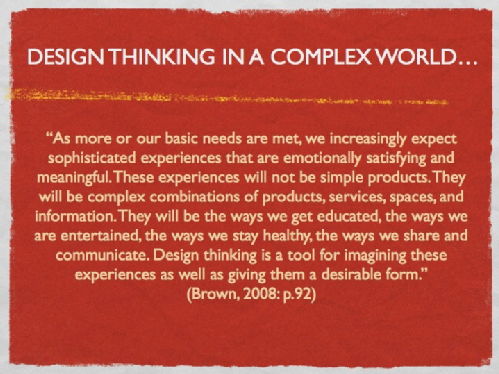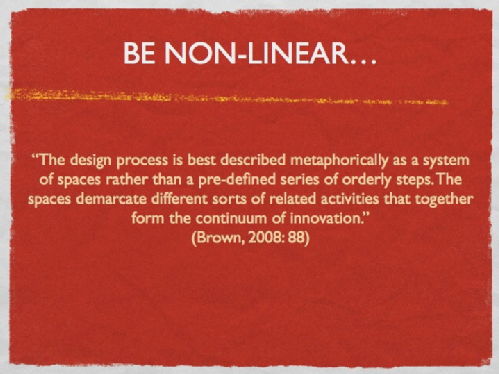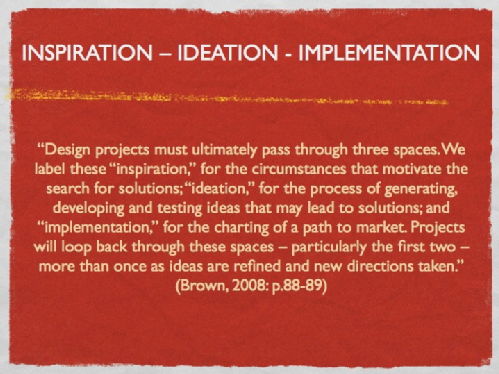All 2 entries tagged Design Thinking
No other Warwick Blogs use the tag Design Thinking on entries | View entries tagged Design Thinking at Technorati | There are no images tagged Design Thinking on this blog
October 11, 2009
Quotes from Design Thinking by Tim Brown
A series of slides used in the first session of my Multimedia Communications workshops for the International Design and Communication Management MA.

The challenge of design is getting more difficult. Conscious and un-conscious expectations and needs are multi-dimensional and sometimes hard to reconcile. A successful design might, for example, need to instill a sense of trustworthiness and reliablity, while at the same time containing an element of playfulness and the in-definite. Only by treating design as a process of discover, of empathy, of dialogue - design thinking - can we create great designs for sophisticated people and complex situations...

Iterate to discover and create. Discover, prototype, test and refine...

Move between the three spaces whenever necessary - allow inspiration to be disruptive of ideation, allow ideation to calm inspiration, don't move to far to implementation to early, but keep it in mind...

The three spaces...

July 27, 2009
Scarcity, inventiveness, cross–pollination, design thinking & pedagogy
In chapter 3 of The Ten Faces of Innovation1, IDEO's Tom Kelley describes an impressive case in which a Nigerian innovator, Bah Abba, had used simple local materials to create an effective evaporation-cooled food storage system. For Kelley, this is more than just a case of overcoming adversity. It demonstrates a particular character from the "design thinking" ensemble: the cross-pollinator. Bah Abba was able to combine disparate elements readily available in the local environment, into an unforeseen combination. The cross-pollinator is particularly important and effective when operating under difficult conditions. In fact, scarcity is the force that drives the cross-pollinator:
There's a principle at work here that we would all do well to respect. Sometimes a lack of resources and tools can prove to be the spark that helps you to seek out and make new connections. It goes beyond the idea that "necessity is the mother of invention." Scarcity and tough constraints force you to break new ground because the "business as usual" path is simply not available. (Kelley & Littman p.78)
What does this mean for learning space design? In his article on Design Thinking2, Tim Brown (also from IDEO) describes how prototyping is an essential part of innovation. This activity takes place in what Brown calls ideation space. Following the IDEO approach, an ideation space is a controlled and safe zone for experimentation, cushioned from the complexities and immediacies of the outside world (it sits alongside two other types of space: inspiration space where the disruptive exigencies of real situations are encountered, and implementation space where we build products to be shipped out and used by real people in real situations). When constructing an ideation space, perhaps we need to embrace scarcity: start with as little as possible: just enough inspiration, just enough cross-pollination. And then add new elements only when necessity drives us back to the inspiration space.
In practical terms, there are some simple implications for pedagogy:
- Make it clear that the students are working in a limited, constrained space.
- Limit the number of ideas and example that can be thrown into the mix.
- Keep the design teams small.
- Use lo-fi prototyping.
- Switch off the internet.
- Use constrained formats (posters, elevator pitches, short films) within ideation processes, so as to concentrate thinking upon the key elements of a problem.
- Allow the students to go out for inspiration when necessary, but limit what they can bring back with them.
When teaching e-portfolio design to the IDCM MA students, the biggest challenge is to get them to understand and operate within the constraints of the available tools: they tend to behave like hyper active cross-pollinators. Next term I will try to use these approaches to get them more focused and more realistic.
________________
1Kelley, T. & Littman, J. The Ten Faces of Innovation: Strategies for Heightening Creativity, Profile Books, 2008
2Brown, T. Design Thinking, Harvard Business Review, June 2008.
 Robert O'Toole
Robert O'Toole

 Please wait - comments are loading
Please wait - comments are loading





